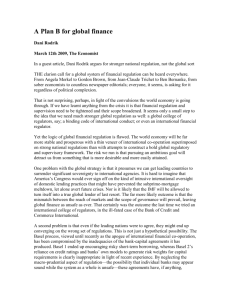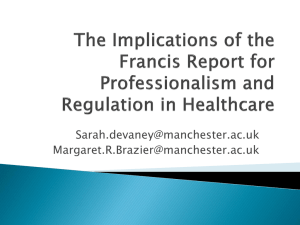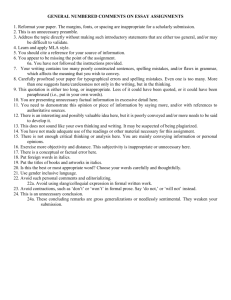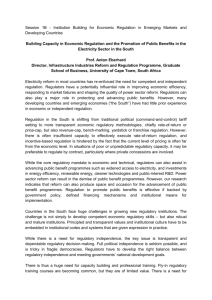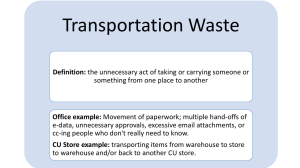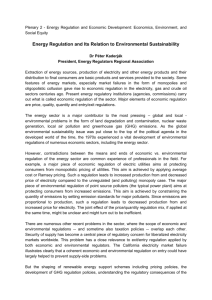What is an unnecessary regulatory burden?
advertisement
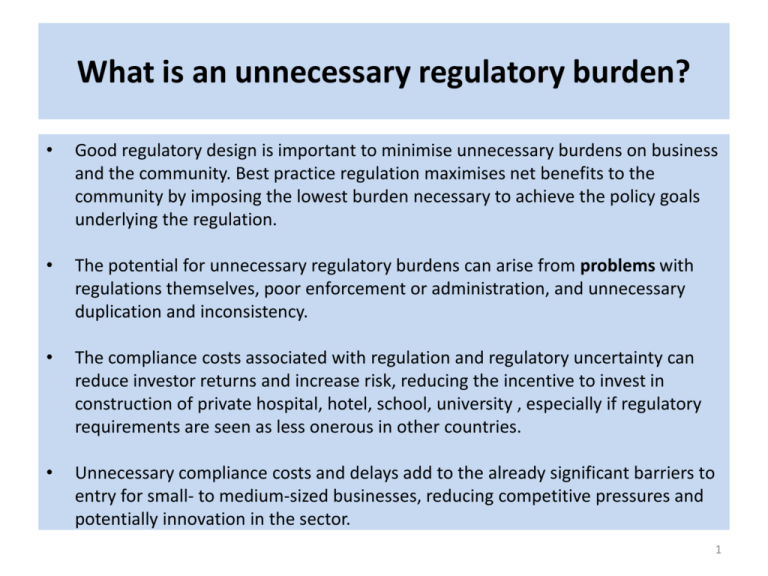
What is an unnecessary regulatory burden? • Good regulatory design is important to minimise unnecessary burdens on business and the community. Best practice regulation maximises net benefits to the community by imposing the lowest burden necessary to achieve the policy goals underlying the regulation. • The potential for unnecessary regulatory burdens can arise from problems with regulations themselves, poor enforcement or administration, and unnecessary duplication and inconsistency. • The compliance costs associated with regulation and regulatory uncertainty can reduce investor returns and increase risk, reducing the incentive to invest in construction of private hospital, hotel, school, university , especially if regulatory requirements are seen as less onerous in other countries. • Unnecessary compliance costs and delays add to the already significant barriers to entry for small- to medium-sized businesses, reducing competitive pressures and potentially innovation in the sector. 1 Sources of potential unnecessary regulatory burdens The potential for unnecessary regulatory burdens arises from a number of sources. However, they can typically be categorised under three broad headings: 1. problems with regulations themselves; 2. poor enforcement and administration; and 3. unnecessary duplication and inconsistency. 2 Problems with regulations themselves Regulations can unnecessarily increase regulatory burdens in several ways: – Unclear or questionable objectives: a lack of clarity provides uncertainty about what is expected of both those being regulated and those regulating. Moreover, it increases the potential for regulators to use their own discretion in determining the intent and priorities of legislators and can lead to inconsistency between regulators interpreting the same piece of legislation. Regulatory uncertainty acts as a disincentive to invest, as well as potentially increasing compliance costs. 3 Problems with regulations themselves (cont’d) Regulations can unnecessarily increase regulatory burdens in several ways: • Conflicting objectives: sometimes regulations (possibly enforced by different regulators) can have objectives that are conflicting. Examples might include safety considerations, that suggest generous spacing, and environmental regulations that seek to minimise a facility’s ‘footprint’ and hence its environmental impact. • Overly complex regulation: complex laws are likely to require legal interpretation and therefore compliance is more costly and more time consuming. They also make it harder to determine the expectations of regulators. • Excessively prescriptive regulation: prescriptive regulation is typically more complex and onerous than objective- or performance-based regulation, is less flexible, can stifle innovation, and may not allow businesses to deliver the policy outcome at least cost. • Redundant regulation: regulation may remain in force despite being overtaken by changed circumstances. While providing no benefits, such regulation will still involve compliance costs and could overlap with more recent legislation, causing regulatory confusion. • Regulatory creep: regulations that influence more areas and activities than were originally intended or warranted. This can stem from the use of subordinate legislation, and regulatory guidelines. 4 Poor enforcement and administration Poor enforcement and administration of regulation can arise from a number of sources: – Excessive reporting or recording requirements: requirements beyond the minimum required to enforce a regulation unnecessarily increase compliance costs. – Inadequate resourcing of regulators (including inexperience or lack of expertise): can delay the time taken for approvals, and potentially lead to poor regulatory decisions. It can also prompt regulators to seek additional, and potentially spurious, information because of a lack of experience or expertise, or to circumvent statutory time limits (where such limits exist). – Overzealous regulation: can increase compliance costs and represents a disincentive to investment. Inadequate resourcing of regulators can lead to problems, but over-resourcing can also, if it results in imposing excessive regulation or micro-management of regulated businesses. particular business or businesses), or lobby groups such as environmental or community groups. 5 Unnecessary duplication and inconsistency • Regulatory duplication and inconsistency between jurisdictions is not inherently bad. It may stem from different circumstances between jurisdictions and, from a competitive federalism perspective, can lead to better overall outcomes. However, duplication and inconsistency can impose some costs: – Duplication of regulation: the need to provide information to multiple regulators and go through multiple processes can add unnecessarily to compliance costs. The existence of multiple regulators also creates incentives for ‘forum shopping’, where participants may seek the forum in which they are most likely to obtain a favourable outcome. Further, it can create uncertainties regarding the boundaries of responsibility for each regulator. On the other hand, regulatory duplication can also be seen as a desirable outcome of intergovernmental competition. – Inconsistency of regulation: regulatory inconsistencies can occur within or across jurisdictions, and increase regulatory burdens. Inconsistency is likely to present particular problems for businesses operating in multiple jurisdictions. – Variation in definitions and reporting requirements: variation can occur between regulators within jurisdictions, although it is typically a more significant problem for businesses operating in multiple jurisdictions. Such variation can increase compliance costs. 6 Information failures • occur where there is insufficient or inadequate information about matters such as price, quality and availability for businesses, investors and consumers to make informed decisions. In some instances, markets can address these problems through intermediary products (for example, advisory services). But where the issues are highly technical, government may perceive a role to complement or verify market-supplied information — for example, permits and CCC for construction building works. 7


